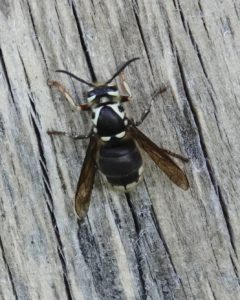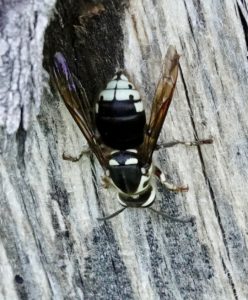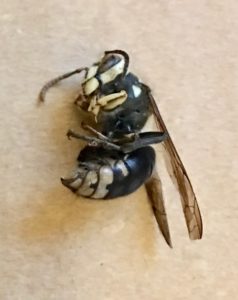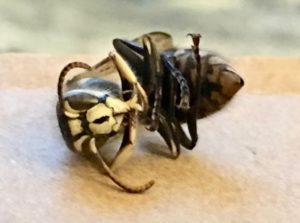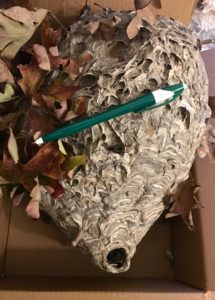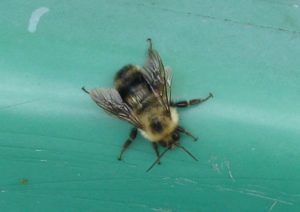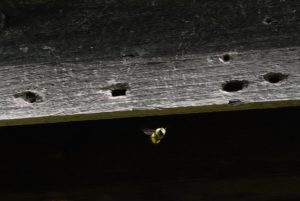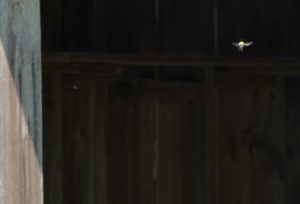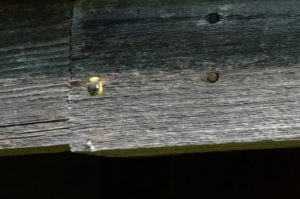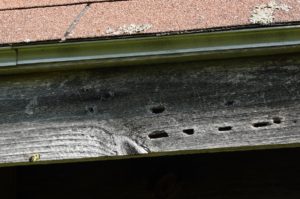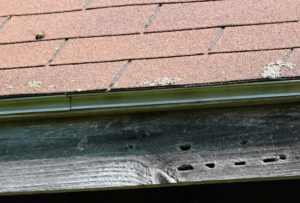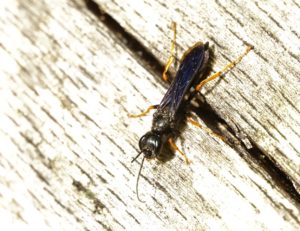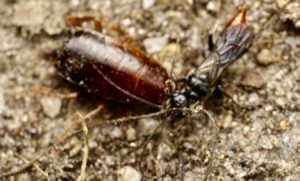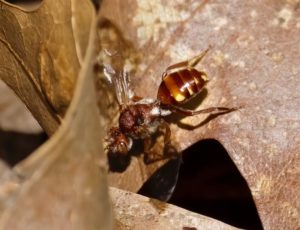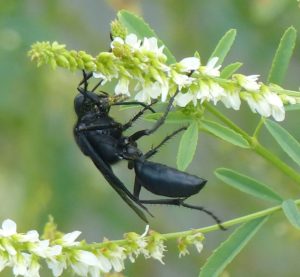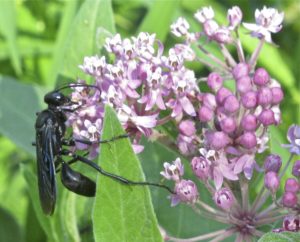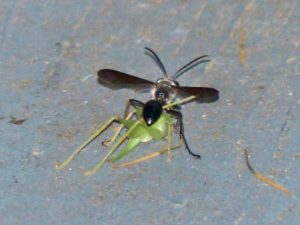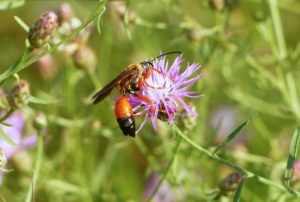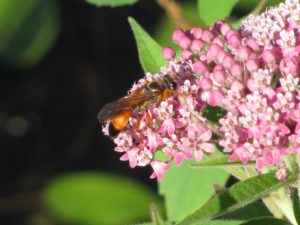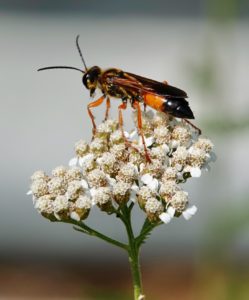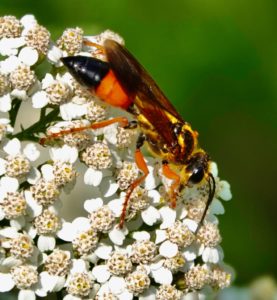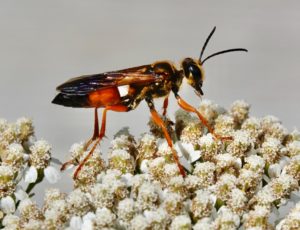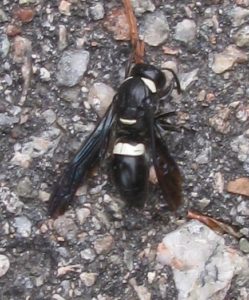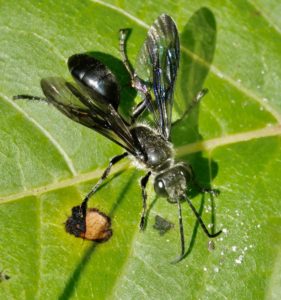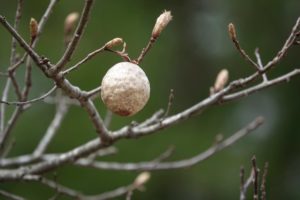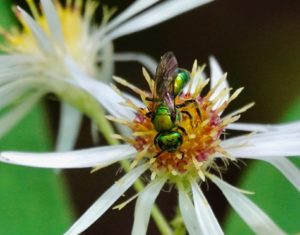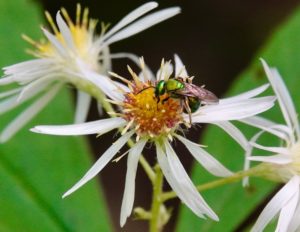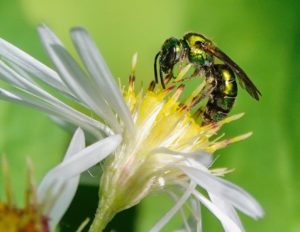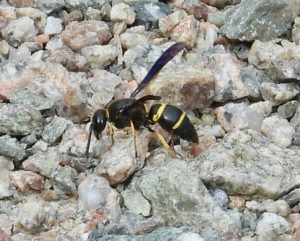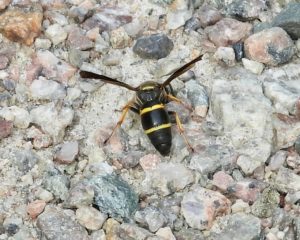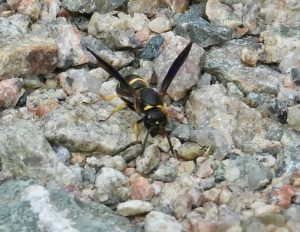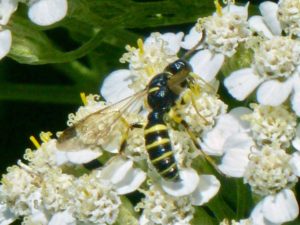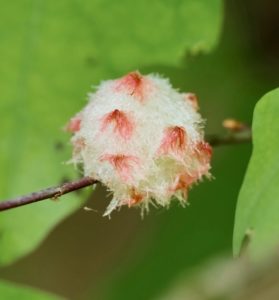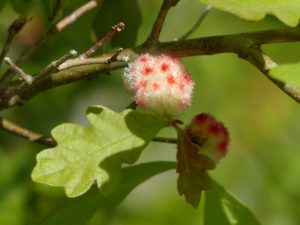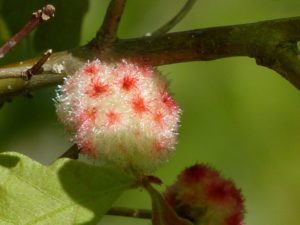Sightings – Hymenoptera (wasps, bees & ants)
Observer: Paul Lauenstein
Observation Date: 5/30/20
Observation Time: 4:30 p.m.
Observation Location: Moose Hill Farm (TTOR)
Common Name: Bald-faced Hornet
Scientific Name: Dolichovespula maculata
Comments: The bald-faced hornet is related to yellowjacket wasps, and is not a true hornet. Its colloquial names include bald hornet, white-faced hornet, white-tailed hornet, spruce wasp, blackjacket, and bull wasp.
Bald-faced hornets are social insects and are most active during the day. They live in colonies of up to 700 members. Bald-faced hornets build paper carton nests in the area of the queen’s choosing, typically three or more feet off the ground, and usually in trees, shrubs, on overhangs, utility poles, houses, sheds or other structures. These nests can be as large as 14 inches in diameter and more than 24 inches in length. The individual in the photos below seemed to be chewing at the dead wood – perhaps to make nest-building wood pulp.
Bald-faced hornets usually appear in late summer. Males emerge from unfertilized eggs and impregnate the new females for the next season at the end of the summer. The inseminated insects are the only ones that overwinter, while the remaining members of the nest die off, and the process repeats the next spring and summer. Unlike other stinging insects, bald-faced hornets do not reuse their nests season after season. The new colony members rebuild them each year from new materials.
Bald-faced hornets are aggressive and will attack anyone who invades their space, unlike other stinging insects that only rarely sting when they feel threatened. Removal of a bald-faced hornet nest is dangerous, and should be left to a professional. These hornets have smooth stingers, so they can sting repeatedly, whereas other stinging insects, like honeybees, are only able to attack once before their stinger falls off.
More Information: Wikipedia
Observer: Richard Mandell
Observation Date: November, 2018
Observation Time: N/A
Observation Location: 280 Mountain Street
Common Name: Bald-faced Hornet
Scientific Name: Dolichovespula maculata
Comments: The bald-faced hornet is related to yellowjacket wasps, and is not a true hornet. Its colloquial names include bald hornet, white-faced hornet, white-tailed hornet, spruce wasp, blackjacket, and bull wasp.
Bald-faced hornets are social insects and are most active during the day. They live in colonies of up to 700 members. Bald-faced hornets build paper carton nests in the area of the queen’s choosing, typically three or more feet off the ground, and usually in trees, shrubs, on overhangs, utility poles, houses, sheds or other structures. These nests can be as large as 14 inches in diameter and more than 24 inches in length.
Bald-faced hornets usually appear in late summer. Males emerge from unfertilized eggs and impregnate the new females for the next season at the end of the summer. The inseminated insects are the only ones that overwinter, while the remaining members of the nest die off, and the process repeats the next spring and summer. Unlike other stinging insects, bald-faced hornets do not reuse their nests season after season. The new colony members rebuild them each year from new materials.
Bald-faced hornets are aggressive and will attack anyone who invades their space, unlike other stinging insects that only rarely sting when they feel threatened. Removal of a bald-faced hornet nest is dangerous, and should be left to a professional. These hornets have smooth stingers, so they can sting repeatedly, whereas other stinging insects, like honeybees, are only able to attack once before their stinger falls off.
More Information: Wikipedia
Observer: Paul Lauenstein
Observation Date: 6/29/10
Observation Time: 7:50 a.m.
Observation Location: Gavins Pond Road area
Common Name: Bumble Bee
Scientific Name: Bombus sp.
Comments: Bumblebees are important pollinators. There are many species of bumblebees.
More information: Bumblebees of the Eastern United States
Observer: Paul Lauenstein
Observation Date: 5/11/23
Observation Time: 10:00 a.m.
Observation Location: Moose Hill Audubon Wildlife Sanctuary (Billings Loop barn)
Common Name: Carpenter Bee
Scientific Name: Xylocopa virginica
Comments: Carpenter bees look like bumblebees, but they have a completely black, shiny, hairless abdomen (the rear section). They mate in April or May. The female carpenter bee starts looking for a suitable nest site, such as weathered areas on buildings, fences, or telephone poles. She chews a hole into the wood and lays her eggs. Adult carpenter bees emerge in August but return to the nest to overwinter. Male carpenter bees hover near the holes that the females bore into wood but they cannot sting. Only the females can sting.
Carpenter bee tunnels occasionally cause minor damage to wooden buildings (note the holes in the wood in the photos). Carpenter bees can be deterred by hanging a fake hornet nest nearby.
More information: Mass Audubon
Observer: Paul Lauenstein
Observation Date: 8/6/12
Observation Time: 1:25 p.m.
Observation Location: near Gavins Pond Dam
Common Name: Cicada Killer Wasp
Scientific Name: Sphecius speciosus
Comments: These large, fearsome-looking wasps burrow in the ground. They are actually not aggressive. I found a sandy area near the Gavins Pond Dam that was peppered with their holes. It took a while to figure out that these holes were made by the wasps.
More Information: University of Kentucky
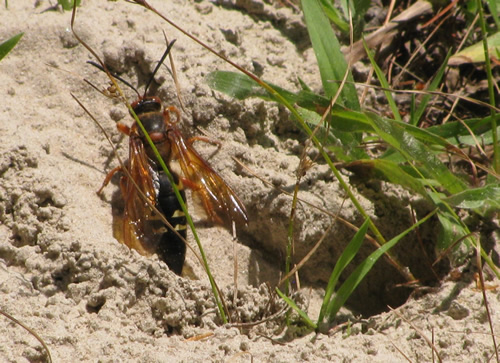
Cicada killer wasp emerging from its burrow:
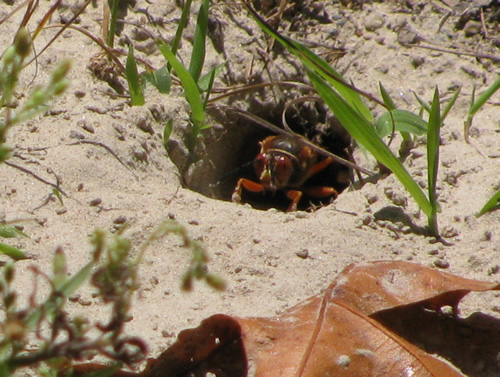
Cicada killer wasp burrows:
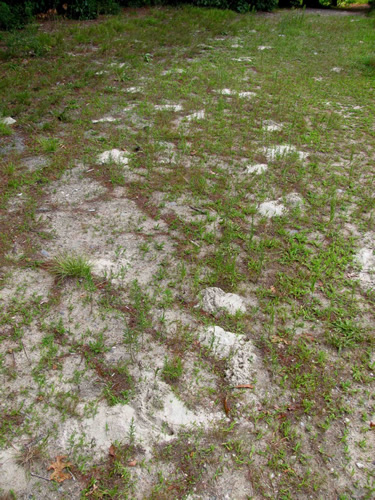
Cicada killer wasp burrow:
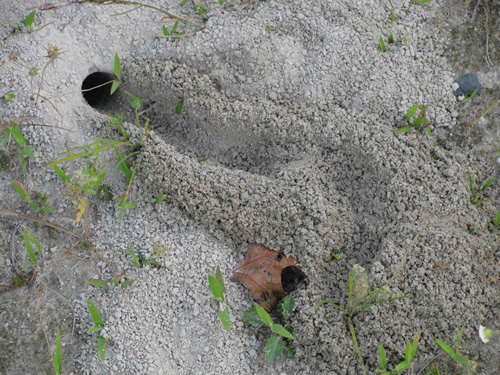
Observer: Gaurav Shah
Observation Date: 9/3/2019
Observation Time: N/A
Observation Location: Borderland State Park, Northwest Trail
Common Name: Cockroach Wasp
Scientific Name: Podium luctuosum
Comments: This is the first record of this genus in Massachusetts according to BugGuide, and only the second in New England (there are other existing records from iNaturalist).
More information: https://bugguide.net/node/view/202008
Observer: Gaurav Shah
Observation Date: 9/3/2019
Observation Time: N/A
Observation Location: Borderland State Park, Northwest Trail
Common Name: Cockroach Wasp
Scientific Name: Dolichurus cf. bicolor
Comments: There are no existing records of this genus in the country in iNaturalist, and only one in BugGuide (which was in Arkansas). This species has one of the most remarkable adaptations in all of nature: they are able to remove the cockroach’s ability to choose to flee, without removing the cockroach’s ability to move, effectively turning it into a zombie that they can lead around.
More information: https://bugguide.net/node/view/22211
Observer: Josh Simons
Observation Date: 5/21/23
Observation Time: 3:05 p.m.
Observation Location: near Gavins Pond
Common Name: Cuckoo Bee
Scientific Name: Nomada maculata
Comments: Cuckoo bees lay their eggs in the colonies of other species of bees so they do not have to raise their own young, much as cuckoo birds lay their eggs in the nests of other birds.
More Information: Wikipedia
Observer: Paul Lauenstein
Observation Date: 7/18/15
Observation Time: 4:40 p.m.
Observation Location: soccer parking lot near Gavins Pond
Common Name: Great Black Wasp
Scientific Name: Sphex pensylvanicus
Comments: Sphex pensylvanicus is a species of digger wasp, commonly known as the great black wasp. It lives across most of North America and grows to a size of 20–35 mm (0.8–1.4 in). The larvae feed on living insects that the females paralyze and carry to the underground nest. Only the females can sting, but they are not aggressive, and only sting to defend themselves.
More Information: Wikipedia
Observer: Paul Lauenstein
Observation Date: 8/17/11
Observation Time: 12:15 p.m.
Observation Location: Gavins Pond Dam
Common Name: Great Black Wasp
Scientific Name: Sphex pensylvanicus
Comments: Sphex pensylvanicus is a species of digger wasp, commonly known as the great black wasp. It lives across most of North America and grows to a size of 20–35 mm (0.8–1.4 in). The larvae feed on living insects that the females paralyze and carry to the underground nest. Only the females can sting, but they are not aggressive, and only sting to defend themselves.
This specimen was seen on a swamp milkweed blossom (Asclepias incarnata)
More Information: Wikipedia
Observer: Paul Lauenstein
Observation Date: 7/18/13
Observation Time: 3:15 p.m.
Observation Location: 4 Gavins Pond Road
Common Name: Great Black Wasp
Scientific Name: Sphex pensylvanicus
Comments: This photo shows a great black wasp carrying a paralyzed katydid to its burrow. Sphex pensylvanicus is a species of digger wasp. It lives across most of North America and grows to a size of 20–35 mm (0.8–1.4 in). The larvae feed on living insects that the females paralyze and carry to the underground nest. Only the females can sting, but they are not aggressive, and only sting to defend themselves.
More Information: Bug Eric
Observer: Paul Lauenstein
Observation Date: 7/20/15
Observation Time: 5:10 p.m.
Observation Location: near Gavins Pond
Common Name: Great Golden Digger Wasp
Scientific Name: Sphex ichnumoneus
Comments: Sphex ichnumoneus is a species of solitary wasp, commonly known as the Great Golden Digger Wasp. This large and colorful wasp can frequently be found nectaring at flowers in late summer and fall. It makes burrows in bare ground or grassy places. As with most species of its genus, it specializes in hunting katydids and bush crickets.
More Information: Cape May Wildlife Guide
Observer: Paul Lauenstein
Observation Date: 7/27/11
Observation Time: 3:50 p.m.
Observation Location: soccer parking lot near Gavins Pond
Common Name: Great Golden Digger Wasp
Scientific Name: Sphex ichnumoneus
Comments: Sphex ichnumoneus is a species of solitary wasp, commonly known as the Great Golden Digger Wasp. This large and colorful wasp can frequently be found nectaring at flowers in late summer and fall. It makes burrows in bare ground or grassy places. As with most species of its genus, it specializes in hunting katydids and bush crickets.
More Information: Cape May Wildlife Guide
Observer: Paul Lauenstein
Observation Date: 7/5/21
Observation Time: 2:10 p.m.
Observation Location: Maskwonicut St. (on the bridge over Beaver Brook)
Common Name: Great Golden Digger Wasp
Scientific Name: Sphex ichnumoneus
Comments: Sphex ichnumoneus is a species of solitary wasp, commonly known as the Great Golden Digger Wasp. This large and colorful wasp can frequently be found nectaring at flowers in late summer and fall. It makes burrows in bare ground or grassy places. As with most species of its genus, it specializes in hunting katydids and bush crickets.
More Information: Cape May Wildlife Guide
Observer: Paul Lauenstein
Observation Date: 7/31/12
Observation Time: 11:15 a.m.
Observation Location: Gavins Pond Dam
Common Name: Honeybee
Scientific Name: Apis mellifera
Comments: Honeybees perform the vital service of pollinating crops. Ward’s Berry Farm in Sharon maintains honeybee colonies for pollinating strawberries and other crops. Honeybees may travel several miles to gather nectar for making honey.
Since 2007, abnormally high die-offs (30–70% of hives) of honeybee colonies have occurred in North America. This has been dubbed “colony collapse disorder” (CCD). It seems to be caused by a combination of factors, possibly including neonicotinoid pesticides.
More Information: Wikipedia

Observer: Paul Lauenstein
Observation Date: 8/17/11
Observation Time: 12:15 p.m.
Observation Location: Gavins Pond Dam
Common Name: Mason Wasp
Scientific Name: Monobia quadridens
Comments: Mason wasps are solitary. They have a metallic blue sheen on their wings. Females usually build nests in abandoned holes of other bee and wasp species. Sometimes mistaken for Bald-faced Hornet, but note the position and extent of white on the abdomen.
More Information: What’s That Bug? and Cape May Wildlife Guide
Observer: Paul Lauenstein
Observation Date: 7/5/21
Observation Time: 2:15 p.m.
Observation Location: Maskwonicut St. (on the bridge over Beaver Brook)
Common Name: Mexican Grass-carrying Wasp
Scientific Name: Isodontia mexicana
Comments: Isodontia mexicana is mainly found throughout North America, but has become established in Europe, primarily France, Switzerland, Hungary, Italy, Serbia, and Spain.
These wasps build their nests in hollowed branches or in other natural cavities, often reusing the nests of other species. Then they line the inside with grass fragments or other plant fibers (hence the name ‘Grass-carrying wasp’).
I. mexicana mainly preys on grasshoppers (usually katydids or tree crickets, choosing the small ones and carrying them to its nest to feed the emerging larvae with the living, but paralyzed prey.
More Information: Wikipedia
Observer: Paul Lauenstein
Observation Date: 9/22/13
Observation Time: 4:00 p.m.
Observation Location: Gavins Pond area near soccer parking lot
Common Name: Northern Paper Wasp
Scientific Name: Polistes fuscatus
Comments: This individual appeared to be gleaning wood fibers for use in constructing or repairing a nest.
More Information: Wikipedia
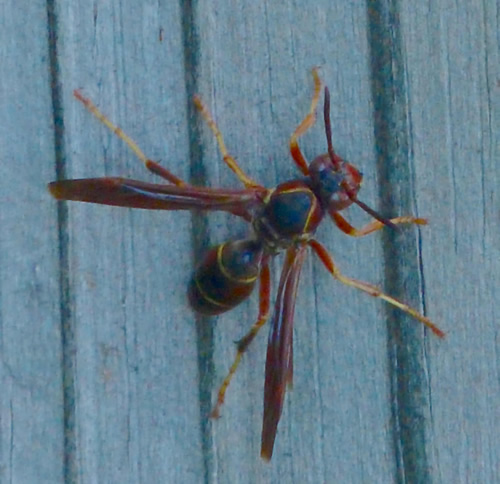
Observer: Paul Lauenstein
Observation Date: 5/11/20
Observation Time: 11:05 a.m.
Observation Location: in a small oak tree in the field across the street from the Gavins Pond soccer fields
Common Name: Oak gall
Scientific Name: caused by small wasps in the family Cynipidae
Comments: Oak apple or oak gall is the common name for a large, round, vaguely apple-like gall commonly found on many species of oak. Oak apples range in size from 2 to 4 centimetres (1 to 2 in) in diameter and are caused by chemicals injected by the larvae of certain kinds of gall wasp in the family Cynipidae. The adult female wasp lays single eggs in developing leaf buds. The wasp larvae feed on the gall tissue resulting from their secretions, which modify the oak bud into the gall, a structure that protects the developing larvae until they undergo metamorphosis into adults. Considerable confusion exists in the general “literature” between the oak apple and the oak marble gall. The oak marble is frequently called the oak apple due to the superficial resemblance and the preponderance of the oak marble gall in the wild. Other galls found on oak trees include the oak artichoke gall and the acorn cup gall, but each of these has its own distinctive form.
Some common oak-apple-forming species are the Biorhiza pallida gall wasp in Europe, Amphibolips confluenta in eastern North America,[2] and Atrusca bella in western North America.
More Information: Wikipedia
Observer: Paul Lauenstein
Observation Date: 9/4/20
Observation Time: 1:10 p.m.
Observation Location: Moose Hill Farm (TTOR)
Common Name: Pure Gold-Green Sweat Bee
Scientific Name: Augochlora pura
Comments: The pure gold-green sweat bee is a solitary sweat bee native to the eastern United States with striking green iridescence. This species is an important native pollinator in eastern deciduous forests and other habitats. It emerges in spring and remains active throughout the summer and early fall. As the common name of this group suggests, sweat bees are attracted to human sweat, which they lick to consume salts.
The specimen in the photos was feeding on a whorled wood aster blossom in the woods.
More Information: U. of Florida Featured Creatures
Observer: Paul Lauenstein
Observation Date: 9/9/13
Observation Time: 2:35 p.m.
Observation Location: Gavins Pond area
Common Name: Red-banded Sand Wasp
Scientific Name: Ammophila sabulosa
Comments: The female red-banded sand wasp first excavates a nest for her larva. After that she hunts a caterpillar, often a moth caterpillar. She then paralyses the caterpillar, but the caterpillar remains alive. Then she carries the caterpillar to the nest. She deposits an egg on the caterpillar. The larva of the wasp develops rapidly. It reaches full size after just 10 days. (Source: Jiri Zahradnik “Bees and Wasps”)
More Information: Wasps
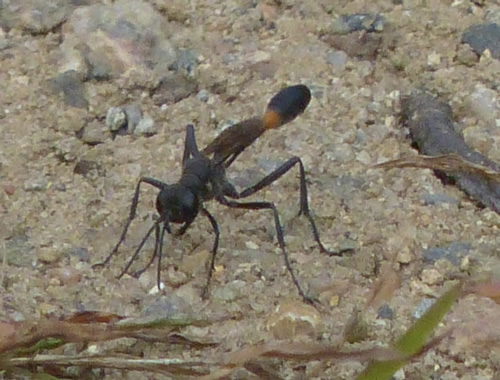
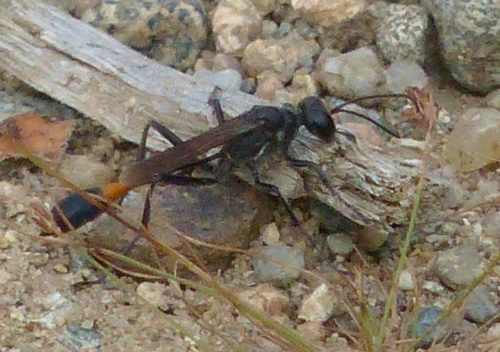
Observer: Paul Lauenstein
Observation Date: 7/16/11
Observation Time: 4:45 p.m.
Observation Location: near Gavins Pond
Common Name: Thread-waisted wasp
Scientific Name: Ammophila procera
Comments: This large solitary wasp (over an inch long) has an interesting life cycle, which is shown in this Vimeo video.
More Information: insectidentification.org
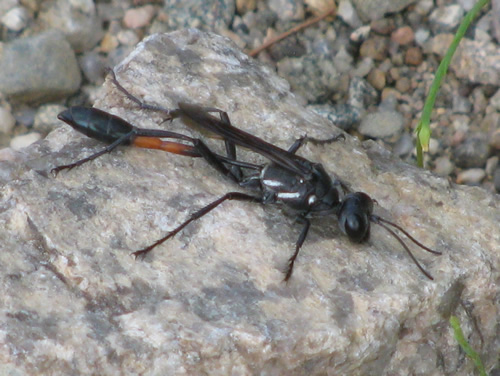
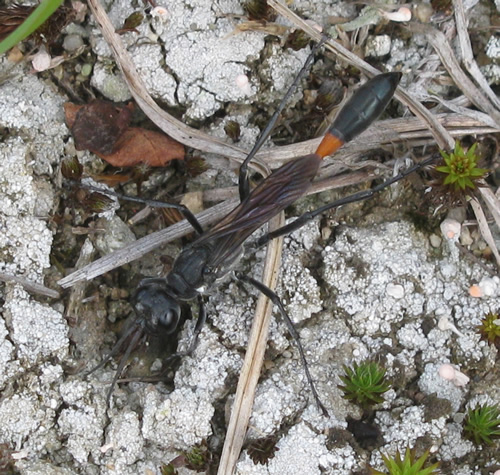
Observer: John Baur
Observation Date: 7/21/23
Observation Time: 4:00 p.m.
Observation Location: Moose Hill (under power lines)
Common Name: unknown wasp species
Scientific Name: Euodynerus undescribed species F
Comments: This small wasp has been identified as a known species that has not been formally described. As such, it is currently known as “Euodynerus undescribed species F”. Once it has been formally described it will be given a normal name, but that could take years.
More information: Bugguide.net
Observer: Paul Lauenstein
Observation Date: 5/19/13
Observation Time: 3:20 p.m.
Observation Location: Gavins Pond area
Common Name: Velvet Ant
Scientific Name: Pseudomethoca simillima
Comments: This ant-like creature is not an ant at all, but rather a wingless wasp. It can sting you, so don’t pick it up!
Watch (and listen) to a velvet ant in action.
More Information: The Backyard Arthropod Project
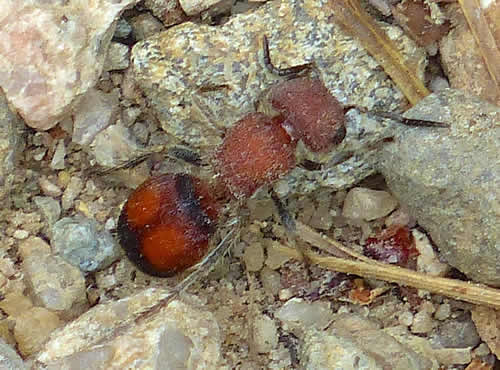
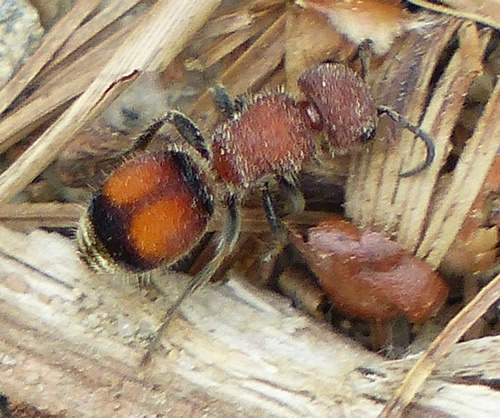
Observer: Paul Lauenstein
Observation Date: 7/7/18
Observation Time: 1:45 p.m.
Observation Location: Moose Hill Farm (TTOR)
Common Name: Weevil Wasp
Scientific Name: Cerceris
Comments: Members of the genus Cerceris hunt weevils and other beetles. Females dig nests in the ground along roads or in areas with loose sand or soil like baseball fields, parks and beaches. They compact the material and create cells where they lay a fertilized egg. They fly off, in search of future food for their larvae.
Female Weevil Wasps bite their prey and paralyze them. The weevil or beetle is then brought back to the nest and stuffed inside a cell where they will remain paralyzed. A hatching wasp larva will immediately begin feeding on the living, paralyzed weevil or beetle. Once the wasp has grown, it will pupate into its adult form and leave the nest.
More Information: Insect Identification
Observer: Josh Simons
Observation Date: 5/21/23
Observation Time: 3:00 p.m.
Observation Location: near Gavins Pond
Common Name: Wool Sower Gall Wasp
Scientific Name: Callirhytis seminator
Comments: Pink-spotted, white cottony wool sower galls are about the size of a ping-pong ball and are produced by a tiny species of Cynipid wasp, Callirhytis seminator, and are most commonly found on white oaks.
More Information: The UnderStory
Observer: Paul Lauenstein
Observation Date: 5/27/10
Observation Time: 4:25 p.m.
Observation Location: Beneath the high tension lines near So. Walpole St.
Common Name: Wool Sower Gall Wasp
Scientific Name: Callirhytis seminator
Comments: Pink-spotted, white cottony wool sower galls are about the size of a ping-pong ball and are produced by a tiny species of Cynipid wasp, Callirhytis seminator, and are most commonly found on white oaks.
More Information: The UnderStory

